98-367 : Security Fundamentals : Part 01
98-367 : Security Fundamentals : Part 01
-
Windows Firewall is a built-in. host-based, stateless firewall.
Select the correct answer if the underlined text does not make the statement correct. Select “No change is needed” if the underlined text makes the statement correct.
- Stateful
- Network layer
- Packet filter
- No change is needed
-
HOTSPOT
Alice sends her password to the game server in plaintext. Chuck is able to observe her password as shown in the following image:
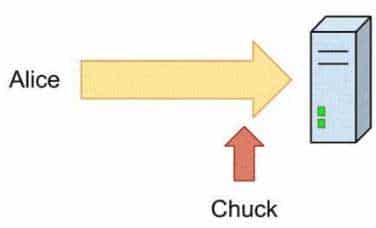
98-367 Part 01 Q02 001 Use the drop-down menus to select the answer choice that completes each statement. Each correct selection is worth one point.

98-367 Part 01 Q02 002 Question 
98-367 Part 01 Q02 002 Answer -
HOTSPOT
For each of the following statements, select Yes if the statement is true. Otherwise, select No. Each correct selection is worth one point.
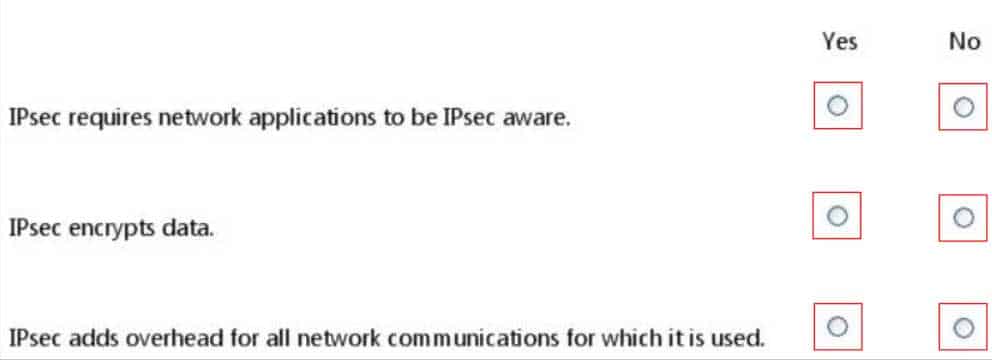
98-367 Part 01 Q03 003 Question 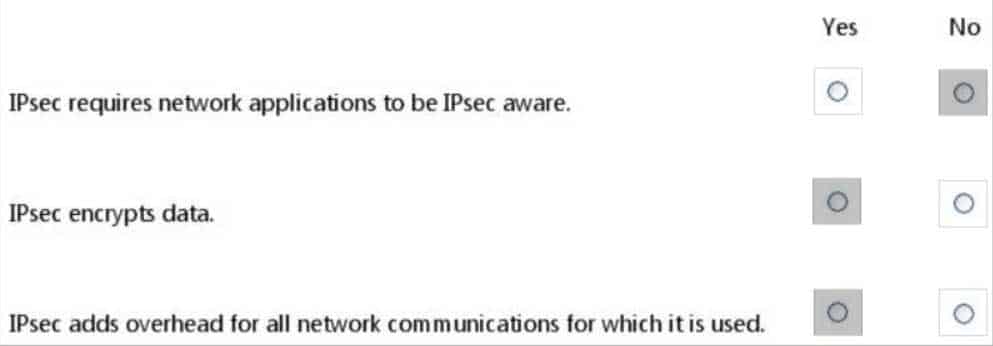
98-367 Part 01 Q03 003 Answer -
HOTSPOT
For each of the following statements, select Yes if the statement is true. Otherwise, select No. Each correct selection is worth one point.
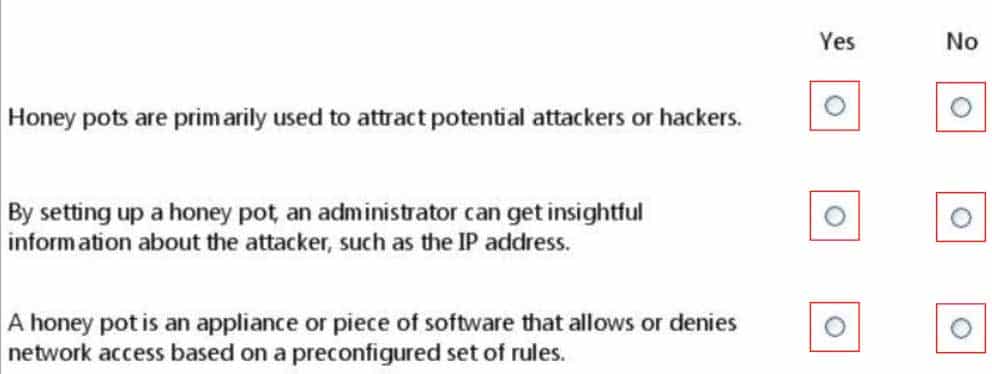
98-367 Part 01 Q04 004 Question 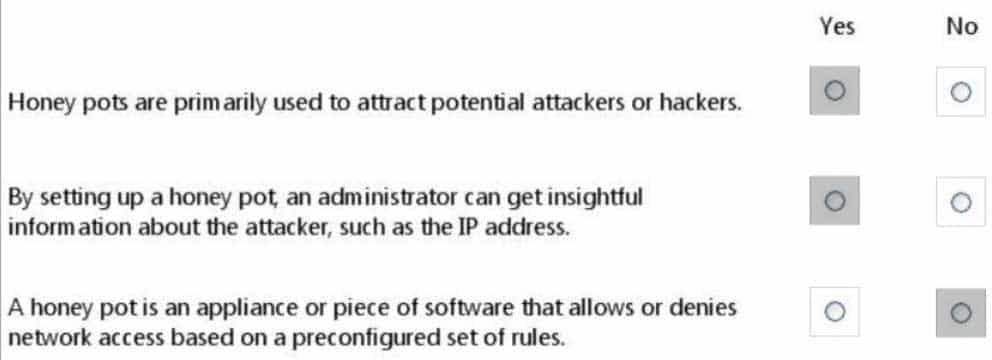
98-367 Part 01 Q04 004 Answer -
Bridging is a process of sending packets from source to destination on OSI layer 3.
Select the correct answer if the underlined text does not make the statement correct. Select “No change is needed” if the underlined text makes the statement correct.
- Routing
- Switching
- Repeating
- No change is needed.
-
The primary purpose of Network Access Protection (NAP) is to prevent:
- Loss of data from client computers on a network.
- Non-compliant systems from connecting to a network.
- Users on a network from installing software.
- Unauthorized users from accessing a network.
Explanation:
NAP enforces health policies by inspecting and assessing the health of client computers, restricting network access when client computers are noncompliant with health policy, and remediating noncompliant client computers to bring them into compliance with health policy before they are granted full network access. NAP enforces health policies on client computers that are attempting to connect to a network; NAP also provides ongoing health compliance enforcement while a client computer is connected to a network. -
You want to make your computer resistant to online hackers and malicious software.
What should you do?
- Configure a forward proxy.
- Install anti-virus software.
- Enable spam filtering.
- Turn on Windows Firewall.
-
HOTSPOT
For each of the following statements, select Yes if the statement is true. Otherwise, select No. Each correct selection is worth one point.
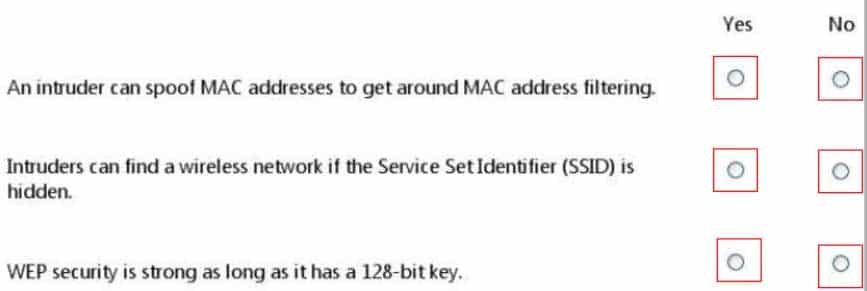
98-367 Part 01 Q08 005 Question 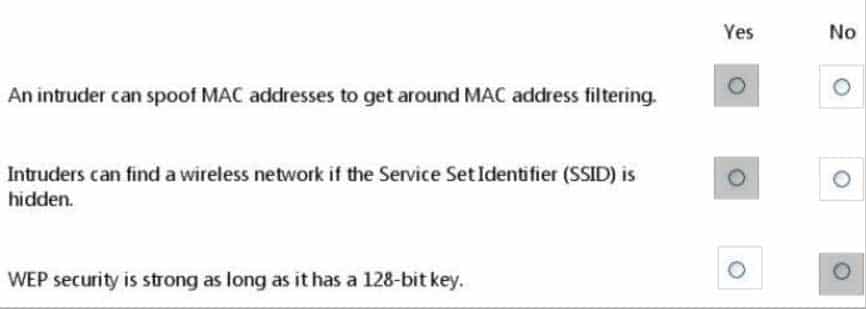
98-367 Part 01 Q08 005 Answer -
Your company requires that users type a series of characters to access the wireless network.
– The series of characters must meet the following requirements:
– Contains more than 15 characters
– Contains at least one letter
– Contains at least one number
– Contains at least one symbolWhich security technology meets these requirements?
- WEP
- WPA2 PSK
- WPA2 Enterprise
- MAC filtering
Explanation: Pre-shared key mode (PSK, also known as Personal mode) is designed for home and small office networks that don’t require the complexity of an 802.1X authentication server.[9] Each wireless network device encrypts the network traffic using a 256 bit key. This key may be entered either as a string of 64 hexadecimal digits, or as a passphrase of 8 to 63 printable ASCII characters -
Many Internet sites that you visit require a user name and password.
How should you secure these passwords?
- Save them to a text file
- Enable session caching
- Configure the browser to save passwords
- Save them to an encrypted file
- Reuse the same password
-
HOTSPOT
You are an intern for a company where your manager wants to be sure you understand the social engineering threats that may occur. Your manager emphasizes the principles of the Microsoft Defense-in-Depth Security Model shown in the following image:
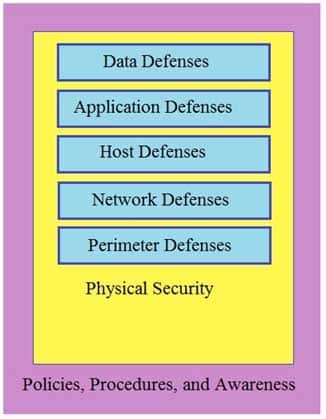
98-367 Part 01 Q11 006 Use the drop-down menus to select the answer choice that completes each statement. Each correct selection is worth one point.
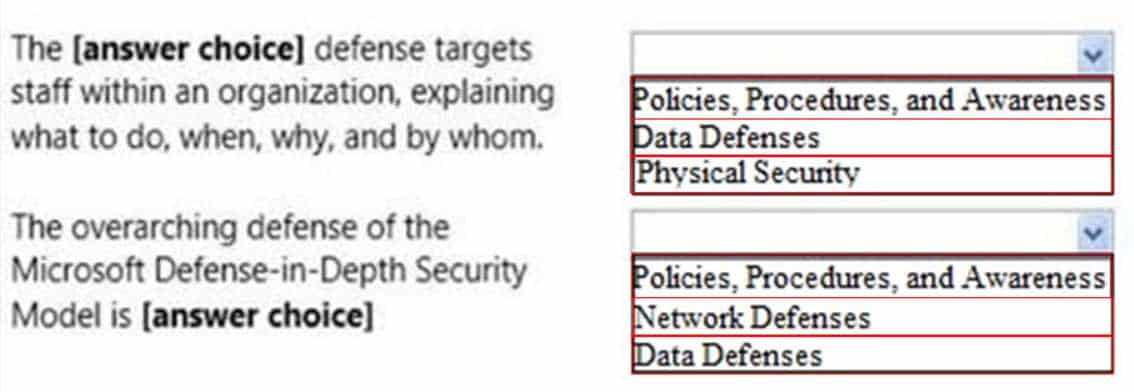
98-367 Part 01 Q11 007 Question 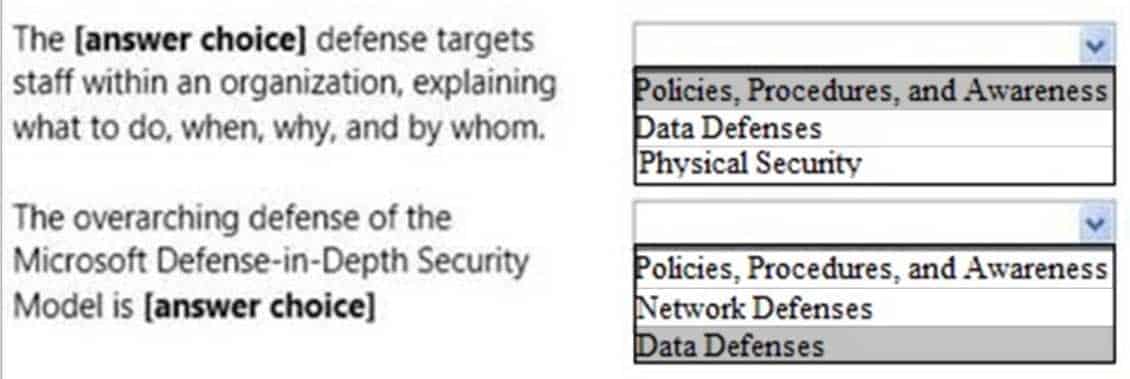
98-367 Part 01 Q11 007 Answer -
Physically securing servers prevents:
- Theft
- Compromise of the certificate chain
- Man-in-the middle attacks
- Denial of Service attacks
-
To prevent users from copying data to removable media, you should:
- Lock the computer cases
- Apply a group policy
- Disable copy and paste
- Store media in a locked room
-
HOTSPOT
For each of the following statements, select Yes if the statement is true. Otherwise, select No. Each correct selection is worth one point.
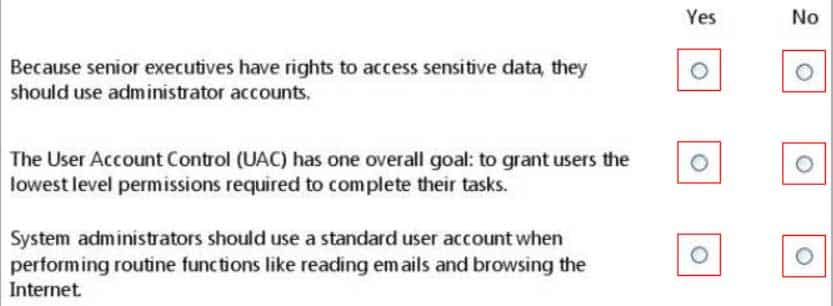
98-367 Part 01 Q14 008 Question 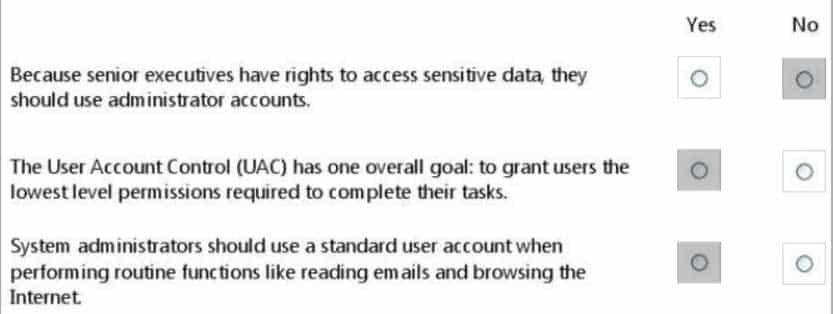
98-367 Part 01 Q14 008 Answer -
You are an intern at Wide World Importers and help manage 1000 workstations. All the workstations are members of an Active Domain.
You need to push out an internal certificate to Internet Explorer on all workstations.
What is the quickest method to do this?
- Local policy
- Logon script
- Windows Update
- Group policy
-
In Internet Explorer 8, the InPrivate Browsing feature prevents:
- Unauthorized private data input.
- Unencrypted communication between the client computer and the server.
- User credentials from being sent over the Internet.
- Any session data from being stored on the computer.
-
The purpose of a digital certificate is to verify that a:
- Public key belongs to a sender.
- Computer is virus-free.
- Private key belongs to a sender.
- Digital document is complete.
Explanation:
In cryptography, a public key certificate (also known as a digital certificate or identity certificate) is an electronic document that uses a digital signature to bind a public key with an identity. -
A mail system administrator scans for viruses in incoming emails to increase the speed of mail processing.
Select the correct answer if the underlined text does not make the statement correct. Select “No change is needed” if the underlined text makes the statement correct.
- Decrease the chances of a virus getting to a client machine
- Verify that the senders of the messages are legitimate
- Ensure that all links in the messages are trustworthy
- No change is needed.
-
You are volunteering at an organization that gets a brand new web server. To make the server more secure, you should add a second administrator account.
Select the correct answer if the underlined text does not make the statement correct. Select “No change is needed” if the underlined text makes the statement correct.
- Disable unused services
- Enable LM authentication
- Enable NTLM authentication
- No change is needed.
-
Role separation improves server security by:
- Enforcing principle of least privilege.
- Installing applications on separate hard disks.
- Physically separating high security servers from other servers.
- Placing servers on separate VLANs.